Table of contents:
Uses of Virtual Reality and Augmented Reality in Education
Benefits of Integrating AR/VR in Education
How to Integrate AR/VR in an LMS
Many educational institutions rely on eLearning technology to amplify the learning experience. They are in constant search for ideal learning management system (LMS) platform. But e-classrooms, paperless textbooks, and recently online classes still remain the prevailing elements of effective education.
But with the growing adoption of remote learning, declining student engagement has become an issue for educators.
In this article, we’ll discuss the role of Augmented and Virtual Reality as a means of boosting student retention and further improving the effectiveness of the educational process.
Uses of Virtual Reality and Augmented Reality in Education
Benefits of Integrating AR/VR in Education
How to Integrate AR/VR in an LMS
Augmented and Virtual Reality have been on a path from their beginnings as expensive gimmicks to a ubiquitous solution, just as smartphones and laptops have become. As the 2019 Augmented and Virtual Reality Survey Report explains, 86% of respondents agree with that statement.
Along with that, another trend will eventually lead to the growth of AR/VR adoption.
Asked about barriers to the spread of these technologies, respondents agreed that bulky hardware and technical glitches are the most prominent obstacles. But, comparing the results to the previous survey, we can see that technical issues are a declining concern.

This decline can be tied to ongoing hardware advancements — for instance, the creation of less hefty wireless VR headsets and implementation of mobile AR.
What about education?
Actually, education is one of the most popular fields for immersive technology applications.
According to the XR Association’s fourth Augmented and Virtual Reality survey, education is believed to be at the top of the list of fields most fit for AR/VR use — right up there with workforce development, manufacturing, and healthcare.
We see the technology being utilized more and more.
For instance, according to the Use of Augmented and Virtual Reality in Remote Higher
Education Review by MDPI, students who participated in AR/VR-enabled remote learning activities increased their academic performance.
Now, let’s review some particular examples of AR/VR used in education.
Augmented and Virtual Reality are applied in various ways to make learning more effective.
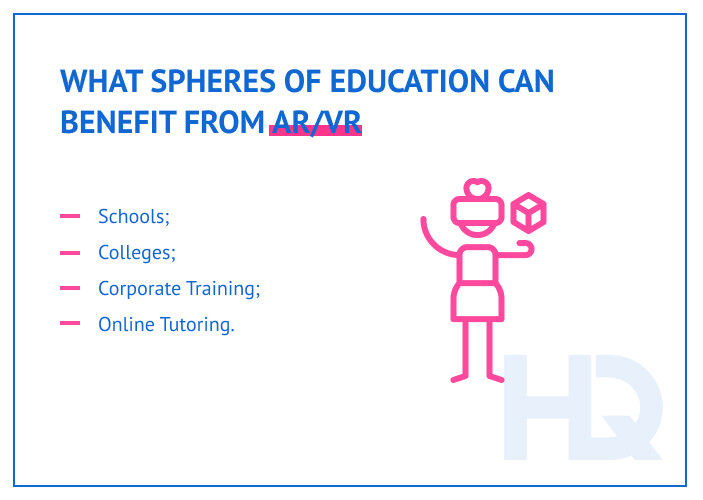
Based on what exactly they do, we can divide the applications into three major types:
This is virtual reality software that provides virtual spaces that can be created from scratch and customized to suit the needs of a user, who can then invite other users to join a class. Class participants can share files, share their computer screens, scribble notes, and talk to each other.
Virtual Reality helps bridge the gap between teachers and students and makes their cooperation more true to life, which is especially beneficial for remote learners.
Online tutors can also get a lot of value from VR training integration.
Applying virtual reality to online tutoring will open new opportunities for teaching in a more immersive manner — thanks to the ability to create whiteboards, draw, take notes, and pull any file right up on the virtual space.
There are a large variety of third-party VR solutions that cater to educational users.
For a fully-featured virtual classroom, we have ClassVR — the software features a complete LMS with Virtual Reality integration to hold classes.
The solution has a ton of educational AR/VR as well as MR content that teachers can use. It also provides a virtual space that teachers can fill with the relevant content. The users can learn through an immersive environment that is completely controllable by the teacher.
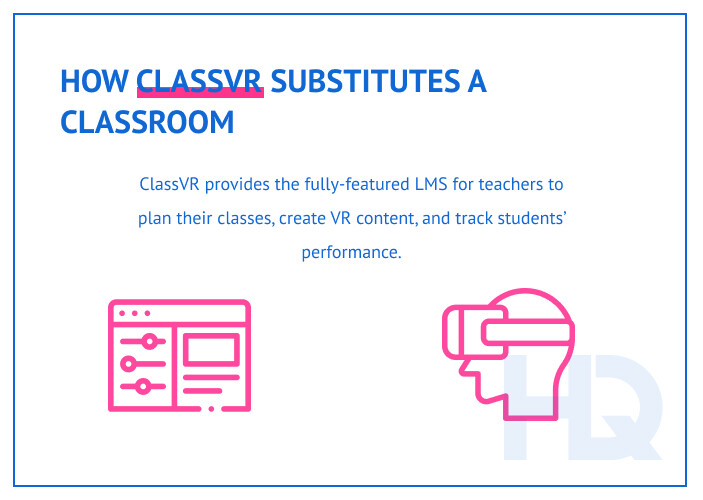
What’s more, there are solutions available that allow for creating beautiful educational content that keeps students engaged.
Brio provides the software for creating training modules with 3D objects, text, and audio, giving students a chance to further polish their skills and knowledge.

Companies can take advantage of VR training solutions to provide their staff with a more immersive experience, especially when a more “hands-on” approach is needed. For example, pilots, electricians, train operators, and so on.
Markerless or marker-based applications provide additional learning information in a more efficient and immersive way. Students can use AR in classrooms to get a 3D model of bone structures, to study the composition of a planet, or get creative in an immersive manner.
Here are a couple of software vendors offering great AR solutions for education.
3DBear provides teachers and students with tools to create anything they want in Augmented Reality. They can use the provided tools to design buildings, illustrate stories, visualize charts, and do other things that will enrich the learning process.
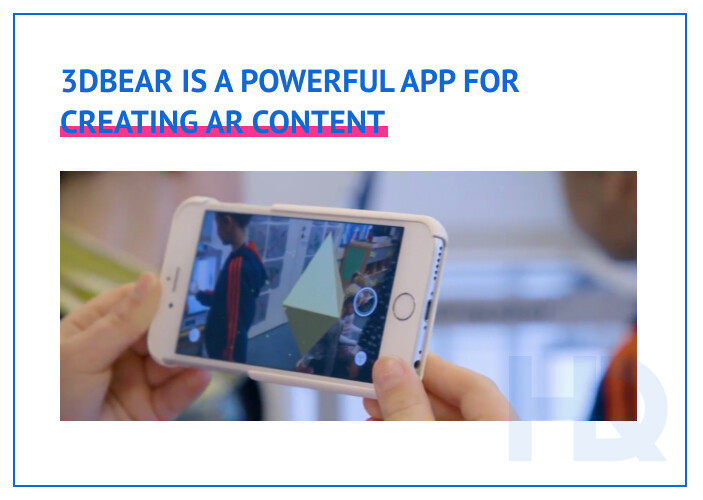
JigSpace lets users create 3D presentations and training courses for complex products. Using the software, users can study how engines are put together or how planes are built, not just by looking at and fiddling with an existing model but also by designing something themselves.
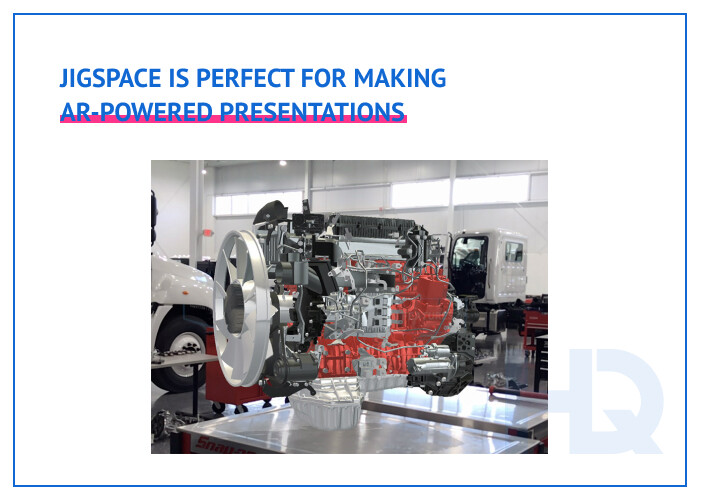
There are also many specialized AR applications for education that can cover particular topics or subjects. For example, Froggipedia is an application that students can use to study anatomy and the life cycle of frogs through Augmented Reality.
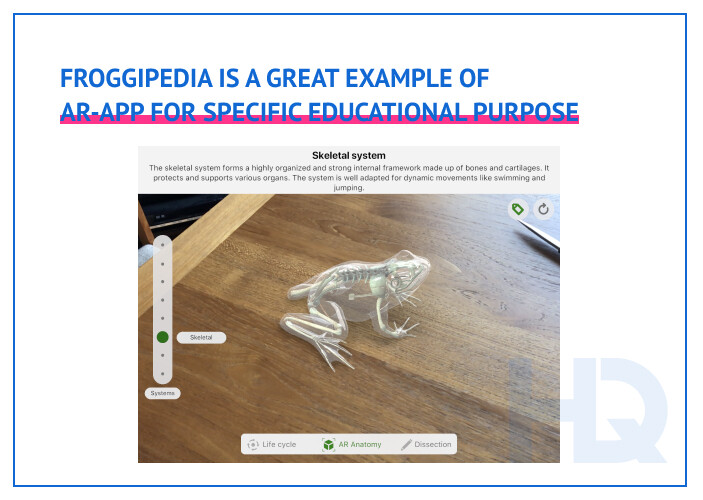
Applying VR-powered solutions to education is bound to improve the effectiveness of teaching in many fields.
Let’s take a closer look at some of the benefits AR/VR solutions can bring to education.
One big advantage of AR/VR learning solutions is that they, and all of the educational content, can be accessed at any time. Students and teachers aren’t restricted by scheduling — everybody can hop onto the platform and study when they have time.
This is great for people who have part-time or even full-time jobs and want to get additional knowledge outside of the curriculum, would like to practice a task, or simply want to revisit the materials as many times as they need to in order to absorb it.
VR learning apps can help with scheduling as well.
With remote VR learning, teachers can schedule classes at any convenient time. This gives teachers more freedom to schedule classes at times that accommodate their needs and those of their students.
And it doesn’t end here.
They also can give assignments for students to work on, on their own, involving activities that otherwise would need to be done in class.
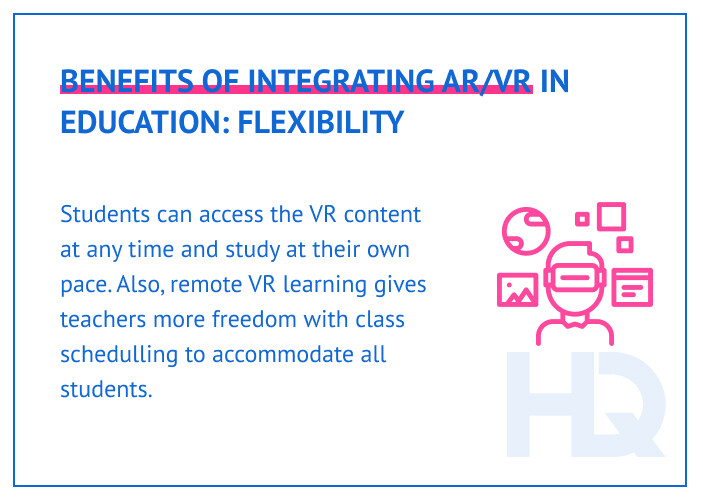
This one is also obvious from the flexibility standpoint.
With the help of VR solutions for learning, students can attend classes remotely.
This is perfect in many scenarios.
For instance, remote classes make education accessible for more people, from different parts of the world. They don’t have to travel or come into the school or college building. Virtual Reality allows for participating in activities that couldn’t otherwise be organized online.
In addition, VR remote learning solutions make education more convenient for disabled people and offer an efficient alternative to offline learning during a quarantine.
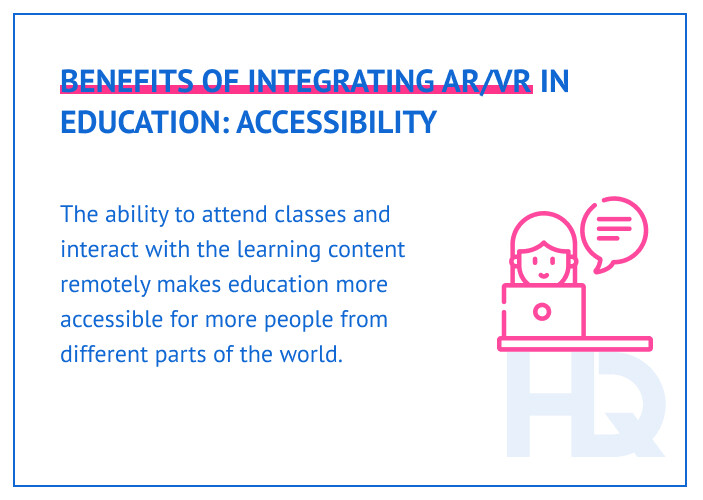
With remote learning, students can significantly cut some education expenses, including travel, fees and other costs for living on or near the campus. This is a particular boon for foreign students.
The same cannot be said, however, about the cost of VR equipment. Prices for headsets are still quite high, with the cheapest legitimate options starting at around $300.
However, the situation is different for Augmented Reality hardware.
AR requires only a mobile device to work, which could be a smartphone or tablet. Most modern devices perform well enough to handle AR, so all of the students would be able to experience educational AR content.
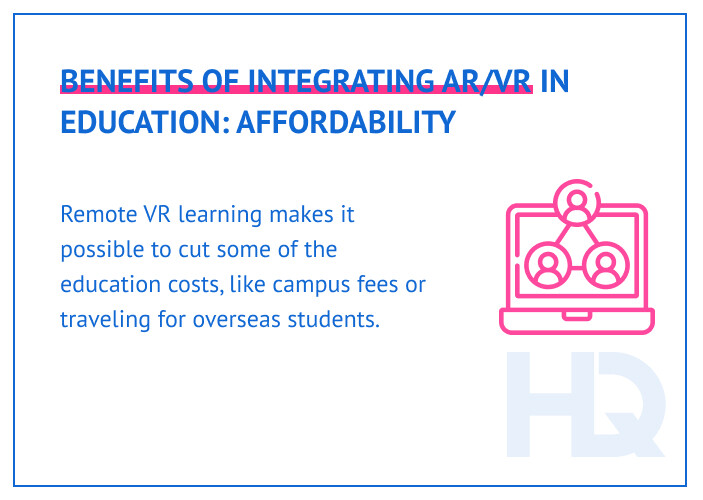
There are plenty of Learning Management Systems that have VR integrated. These systems are usually fully featured for planning and scheduling classes, reviewing student progress, creating educational content, and managing tasks.
Such a system gets better the longer you use it.
They have powerful analytics that can track the efficiency of particular courses, tasks, and even the whole curriculum.
Also, the teacher can analyze the students’ performance to see where they need to improve.

AR/VR learning apps open a whole new world of creating educational content. Using the provided tools, teachers can create AR/VR classes that allow students to study the subject hands-on rather than by looking at a picture in a textbook.
In addition, there are interactive games, quizzes, and tests to add to the mix.
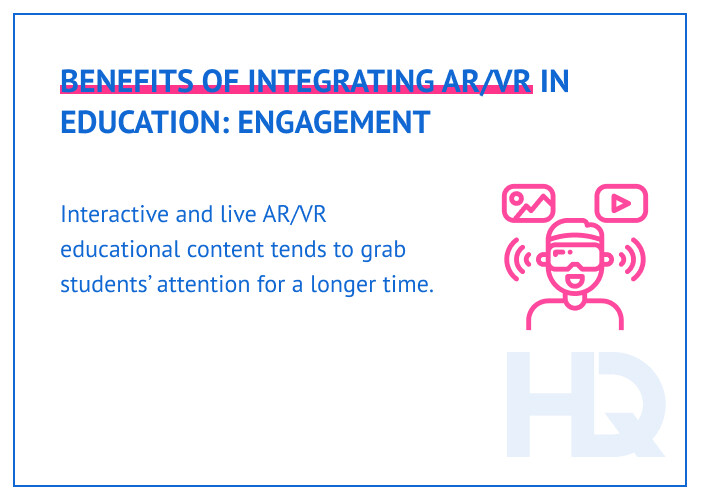
Now let’s talk about actually building AR/VR tech into your LMS.
There is no doubt that implementing Augmented or Virtual Reality in an education solution or building a VR-powered learning app from scratch is a difficult task, given the complexity of that technology.
Looking to integrate AR/VR into your LMS?HQSoftware has the professionals you need for the project. Let’s discuss your ideas!
Anna Halias
Business Development Manager
The best way to go about it is by hiring a team of software developers with deep experience in building AR/VR educational apps.
Here’s how:
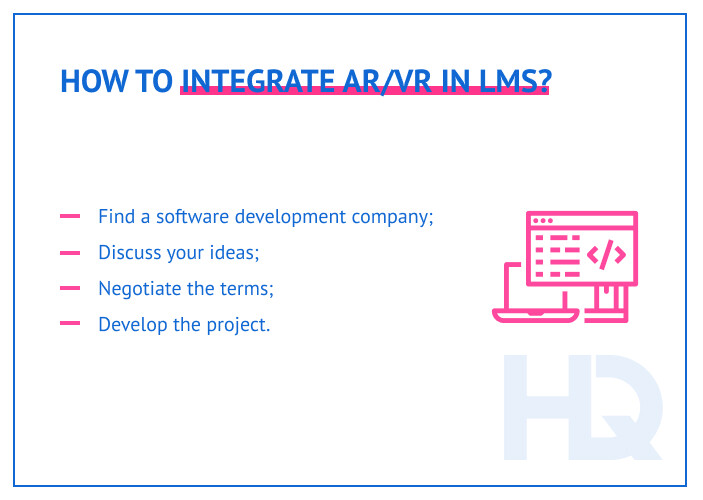
The cost of integrating AR/VR in an LMS will vary quite a bit, since there are several factors that influence the price and they are always changing.
Most of those factors depend on the software vendor you choose.
Let’s start with the easy ones:
Now, on to the vendor-specific factors that influence the AR/VR project cost:
Take a look at the rough estimation below of time and costs for a typical AR/VR-powered learning app. The costs are calculated based on the average developer’s rates from the Estonia region and the approximate time scope for the project.
Note that the costs are not final and might change depending on your needs:
| App Type | Development time | Development cost |
| Marker-based/Markerless AR app | 200–510 hours | $7000–$18000 |
| Window on world VR | 104–150 hours | $4000–$6000 |
| Fully immersive VR | 280–340 hours | $10,000–$12,000 |
The HQSoftware team has built several projects implementing Augmented and Virtual Reality to enhance workflows in various domains. We have also built strong e-learning software for corporate clients.
Let’s take a look at some examples.
The HQSoftware team has developed a mobile AR app that helps with equipment maintenance and repairs.
The challenge for the client was to provide technical staff with clear manuals for maintaining complex equipment without the help of experts.
To solve the problem, HQSoftware built an app that used Augmented Reality to provide interactive repair and maintenance guides.
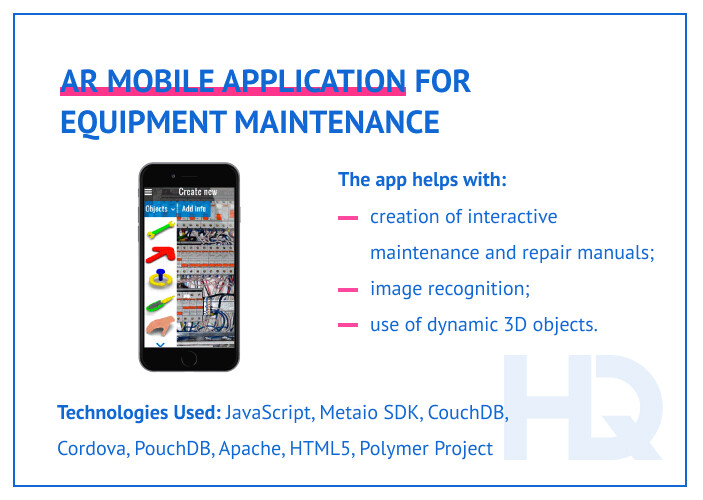
Our team has worked on a training system that relies on Virtual Reality to help users acquire technical skills or master a new profession remotely.
The main challenge was to create engaging, effective, and authentic training simulations to help trainees build their skills while addressing misconceptions and complying with particular industry standards.
For example, one of the simulations developed by HQSoftware for the client is called “Basics of Soldering.” A beginner can study the technological process in a virtual room and then repeat all the steps with the help of “ghost hands.”
The system also allows for tool calibration to make interaction as precise and intuitive as possible. This way, interaction with a virtual object feels more realistic. There is also built-in AI that can recognize when trainees make mistakes and correct them.
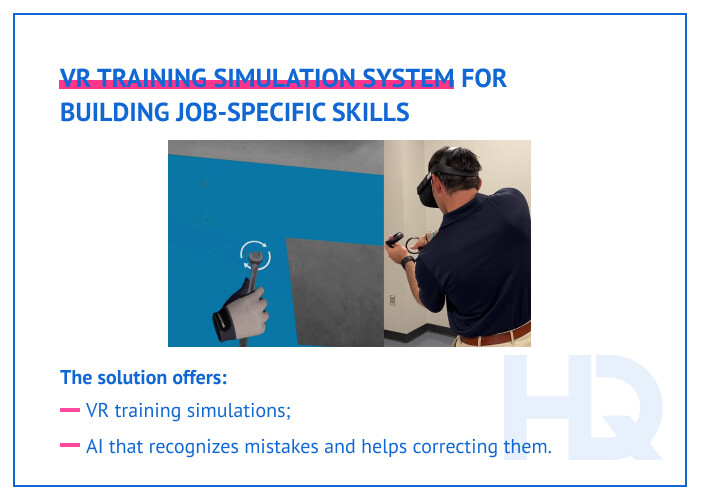
Implementing AR/VR into education sounds great, right?
But what will happen to it in the future? Is it here to stay?
Educators agree that Augmented and Virtual Reality has proved effective at providing a personalized and differentiated experience for both learning and teaching.
With further advances of the technology, we will surely see more advanced applications of AR and VR in the education field.
Having started with simple Window on World VR, marker-based AR apps, teachers will get the benefit of more fully immersive experiences going forward.
The hardware is also getting better year over year, so we can expect easier access for schools.
With some educational VR software vendors already providing VR headsets for schools, we will most definitely see more compact, easily portable, and affordable devices making their way into classrooms.
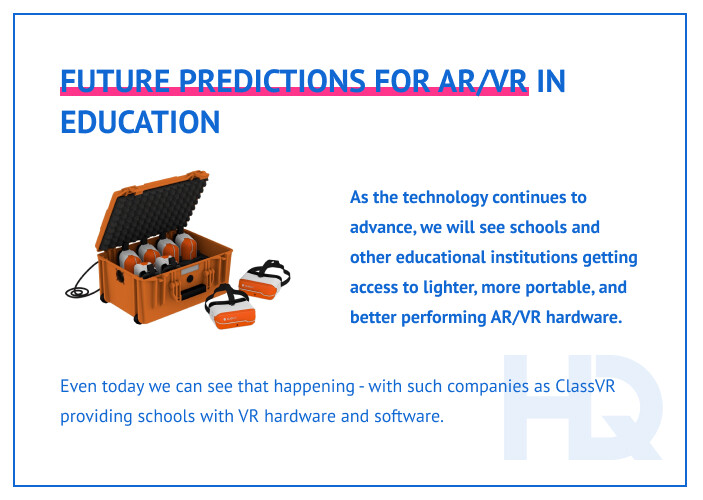
Another great addition to AR/VR hardware is LIDAR technology. It takes environment scanning to the next level, allowing for the creation of high-quality 3D models of objects. That drastically improves surface scanning for AR and object scanning for VR.
When it comes to software advancements, we will definitely see improvements to WebAR technology. The ability to avoid downloading an app and just experiencing AR content through a web browser can lower the threshold for more potential users.
If you are looking to integrate Augmented or Virtual Reality in an existing learning management system or build one from the ground up — talk to us.
HQSoftware’s development team has completed numerous educational projects, as well as gained deep expertise in developing AR/VR software solutions.
Partnering with HQSoftware, you will get a detailed specification of your project along with the time scope and cost breakdown. Experienced PMs make sure that the development process goes smoothly and all of the features are implemented correctly.
Drop us a line if you want to learn more!
We are open to seeing your business needs and determining the best solution. Complete this form, and receive a free personalized proposal from your dedicated manager.

Sergei Vardomatski
Founder